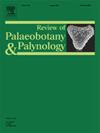一种罕见的过矿化的叶藻(叶藻科,叶藻科)茎,含有丰富的真菌残留物,来自法国中部的奥顿的二叠纪
IF 1.7
3区 地球科学
Q2 PALEONTOLOGY
引用次数: 0
摘要
今天的蕨类植物,即木贼属的物种,是各种真菌的宿主。尽管叶藻的进化史很长,过去的种类也比现在多得多,但人们对与这组自由孢子维管植物化石代表相关的真菌知之甚少。来自法国早二叠世秋季盆地的一种过矿物质化的叶ophyllum茎在木质部和周皮中含有几种类型的真菌遗迹,包括过叶壶状菌体、菌丝尖端类似简单球囊孢子的囊胚膨胀、具有夹紧连接的担子菌菌丝,以及功能未知的致密三维菌丝结构和系统亲和力。外周细胞壁的附着证明至少有一种真菌在其活着时定植在茎上。一个地语学上的特点是气管中菌丝的痕迹化石,里面充满了琥珀色到棕色的物质,可能是一种胶质。这只是第二次从苔藓化石的气生部分发现真菌的报道。越来越多的证据表明,不同的真菌群落与石炭纪和早二叠纪煤沼泽森林的标志性植物有关。本文章由计算机程序翻译,如有差异,请以英文原文为准。
A rare permineralized Sphenophyllum (Sphenophyta, Sphenophyllales) stem containing abundant fungal remains from the Permian of Autun, central France
Present-day sphenophytes, i.e. the species of the genus Equisetum, are hosts to a variety of fungi. Although the Sphenophyta have a long evolutionary history and were far more diverse in the past than they are today, little is known about fungi associated with the fossil representatives of this group of free-sporing vascular plants. A permineralized Sphenophyllum stem from the early Permian Autun Basin in France contains several types of fungal remains in the xylem and periderm, including a Perexiflasca-like chytrid thallus, blastic inflations of hyphal tips resembling simple glomoid spores, basidiomycete hyphae with clamp connections, and compact, three-dimensional hyphal structures of unknown function and systematic affinity. Cell wall appositions in the periderm are evidence that at least one of the fungi colonized the stem while it was alive. A taphonomic peculiarity are trace fossils of hyphae in tracheids filled with an amber-colored to brown substance, perhaps a type of gum. This is only the second report of fungi from the aerial parts of a fossil sphenophyte. It adds to the growing body of evidence that diverse fungal communities were associated with the iconic plants of the Carboniferous and early Permian coal swamp forests.
求助全文
通过发布文献求助,成功后即可免费获取论文全文。
去求助
来源期刊
CiteScore
3.50
自引率
21.10%
发文量
149
审稿时长
6 months
期刊介绍:
The Review of Palaeobotany and Palynology is an international journal for articles in all fields of palaeobotany and palynology dealing with all groups, ranging from marine palynomorphs to higher land plants. Original contributions and comprehensive review papers should appeal to an international audience. Typical topics include but are not restricted to systematics, evolution, palaeobiology, palaeoecology, biostratigraphy, biochronology, palaeoclimatology, paleogeography, taphonomy, palaeoenvironmental reconstructions, vegetation history, and practical applications of palaeobotany and palynology, e.g. in coal and petroleum geology and archaeology. The journal especially encourages the publication of articles in which palaeobotany and palynology are applied for solving fundamental geological and biological problems as well as innovative and interdisciplinary approaches.

 求助内容:
求助内容: 应助结果提醒方式:
应助结果提醒方式:


